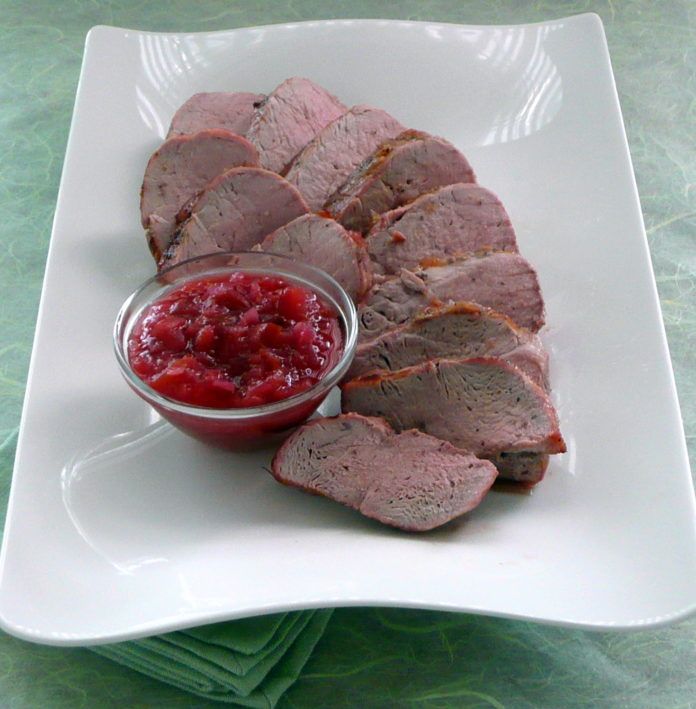Ingredients
- 1/2 pound fresh plums, pitted and coarsely chopped
- 1/2 cup chopped red onion
- 2/3 cup water
- 1/4 cup packed light brown sugar
- 1/4 cup apple cider vinegar
- 1 tbsp finely grated fresh ginger
- 1 tsp freshly grated orange zest
- 1/2 tsp ground coriander
- 1 pinch crushed red pepper
- 1/4 tsp salt
- 1 pound natural pork tenderloin, trimmed (see ingredient note)
- 1 tsp canola oil
- 1/4 tsp black pepper
Pork and plums are a time-honored pairing. In this recipe late-season plums and spices are simmered into a flavorful chutney to accompany lean pork tenderloin. The simple chutney does double duty as a glaze and a sauce. It is also delicious with poultry and can be used to perk up crackers and cheese.

To make chutney: Place plums, onion, water, sugar, vinegar, ginger, orange zest, coriander, crushed red pepper and pinch of salt in small heavy saucepan. Bring to a simmer over medium-high heat. Reduce heat to medium-low and simmer briskly, uncovered, stirring from time to time, until plums have broken down to form a chunky sauce and chutney has thickened, 20 to 30 minutes. Measure out cup chutney to use for glazing pork; reserve remainder to accompany pork. Let cool. (Chutney will keep, covered, in the refrigerator for up to 1 week. Bring to room temperature before serving.)
Heat grill. Trim pork. If tenderloin has a thin tail, tuck it under and secure with butchers twine to make a more-or-less even shape. Brush pork with oil. Sprinkle with tsp salt and pepper. Lightly oil grill rack by rubbing it with a piece of oil-soaked paper towel; use tongs to hold paper towel. (You can also use a nonflammable grill spray, such as Weber Grill Spray for no-stick grilling.
Do not spray regular cooking spray on a hot grill.) Place pork over direct medium heat, cover and grill, turning from time to time to brown it all over, 10 minutes. Brush with some of the chutney glaze. Continue grilling, turning and brushing with additional glaze, until an instant-read thermometer inserted in the thickest portion registers 145F, 10 to 15 minutes longer. Transfer pork to a clean cutting board. Let rest at least 3 minutes (the temperature will rise during resting) before carving into -inch-thick slices. (Use this time to steam your favorite vegetables.) The meat should be juicy with just a trace of pink.
Serve with chutney.
Yield: 4 servings (approximately 3 oz cooked meat and 3 Tbsp chutney each).
Per serving: Calories: 210. Total fat: 4 grams. Saturated fat: 1 gram. Cholesterol: 55 milligrams. Sodium: 230 milligrams. Carbohydrates: 23 grams: Fiber: 1 gram. Protein: 20 grams.
Food Safety Note: In 2011, the United States Department of Agriculture revised its guidelines for a safe internal temperature for pork. Previously, the agency recommended cooking pork to an internal temperature of 160F, but current guidelines advise that an internal temperature of 145F with a resting period of 3 minutes is safe. This lower temperature ensures a juicier result. The USDA recommends that using a thermometer is the only sure way to determine doneness. Start checking for doneness shortly before the recommended cooking time. Wash thermometer with hot soapy water before and after each use.
Ingredient Note: Enhanced pork has been injected with a sodium phosphate solution in order to enhance tenderness and moisture. The USDA requires that enhanced pork be clearly labeled. The label will state that the product contains an xx% solution of sodium phosphate (percentage varies depending on the meat packer). As you may guess, this type of meat has a higher sodium content than a natural product. For example, made with natural pork, a serving of our pork tenderloin recipe has 230 milligrams of sodium. Made with enhanced pork, a serving would have 430 milligrams of sodium. In our recipes tests, we found that when cooked according to recipe directions, the natural pork was juicy and flavorful.
Tip: If you prefer to cook the pork in the oven, first brown it in 1 tsp oil in a large skillet over medium-high heat, 4 to 5 minutes. Spoon chutney glaze over top of pork. If skillet is ovenproof, place skillet in oven. If it is not ovenproof, transfer pork to small roasting pan. Roast pork at 400F until instant-read thermometer registers 145F, 15 to 20 minutes.
























